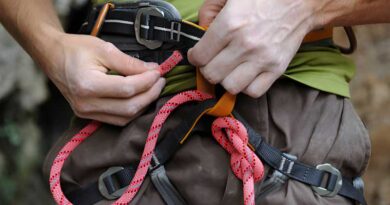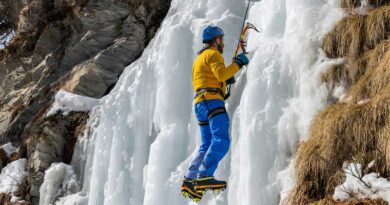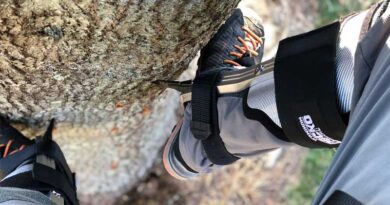Best Approach Shoes for Wide Feet of 2025
Approach shoes combine the features of hiking shoes and climbing shoes in a brand-new category. They offer both stability and traction on rocky surfaces, while also ensuring comfort during long hikes on the trail. For those with wide feet, finding the perfect pair of approach shoes can be a daunting task. Because the wrong fit can cause discomfort, pain, and even injury. In this article, I have reviewed 8 of the best approach shoes available in the market for people with wide feet. I will examine the features that make them suitable for wide feet and provide helpful tips to help you make an informed purchase decision.
1. La Sportiva Boulder X
Weight (pair): 2 lbs. 2 oz.
Upper: Leather
Midsole: EVA
Outsole: Vibram Idrogrip
La Sportiva Boulder X is a rugged approach shoe designed to provide excellent grip and support on rough terrain. One of the most impressive features of this shoe is its excellent toe protection. The reinforced rubber toe cap effectively shields your toes from accidental bumps and scrapes, ensuring that your feet remain safe and comfortable throughout your hike. The Vibram sole of the Boulder X also provides outstanding traction, giving you the confidence to tackle challenging routes. The upper of the Boulder X is made of durable suede leather, which not only provides excellent durability but also adds a touch of style to the shoe. The breathable mesh lining keeps your feet cool and comfortable even during extended use. The lacing system is easy to use and allows for a customized fit.
However, there are some drawbacks to the Boulder X. One is that the shoe can be quite stiff, which may take some time to break in. Also, the laces come untied easily, requiring frequent readjustments. Second, the shoe is too heavy to wear on a harness, it doesn’t edge well on 5th-class terrain, and the bulky soles don’t work well with aluminum crampons. Furthermore, when wet, the leather upper stretches so much that your feet twist in the toe box, resulting in a tear where the rubber rand meets the leather.
What I like: Stick rubber and affordable
What I don’t: Heavy and bulky.
See the La Sportiva Boulder X See the Women’s Boulder X
2. La Sportiva TX4 EVO
Weight (pair): 1 lb. 12 oz.
Upper: Nubuck leather
Midsole: Traverse Injection MEMlex
Outsole: Vibram Megagrip
The La Sportiva TX4 is an excellent hiking shoe that climbs exceptionally well, making it the Top Pick for Heavy Loads and Big Walls this season. Its wide toe box provides comfort, and the sticky Vibram rubber and moderate stiffness allow it to handle low-angle slabbage and easy crack climbing. The shoe’s sensitive “climbing zone” at the toe makes it easier to feel smaller edges down to a quarter of an inch. It doesn’t edge as well as the Top Pick For Climbing, but it feels more secure edging than many other models. The TX4 smears at least as well as other sticky rubber shoes in the selection. The shoe offers loads of support and traction for scrambling easy routes and descending hills.
The TX4 is the tester’s favorite shoe for long approaches with heavy packs. The lacing system provides a highly adjustable system that allows for dialing in the tightness of the shoe. The Traverse injected MEMlex midsole keeps the testers stable and comfortable while descending talus and scree. The TX4 offers loads of support, making it the best approach shoe for carrying heavy loads into the backcountry. It’s a killer value and sits solidly in the middle of the approach shoe price range.
The shoe’s weakness is its weight and bulkiness, earning it a middle-of-the-road score in this metric. The shoe is not as comfortable or light on the back of harnesses as ultralight and lower-profile models. However, the comfortable and supportive TX4 is still lighter than some less supportive options. The pull tabs are durable and haven’t broken after hundreds of uses. The La Sportiva TX4 is versatile, durable, and an all-leather shoe that is among the most versatile approach shoes available.
What I like: The leather upper is extremely durable and fits well.
What I don’t: Breathability may be limited in the summer’s heat.
See the La Sportiva TX4 EVO See the Women’s TX4 EVO
3. KEEN Jasper

Weight (pair): l lb.
Upper: Suede leather
Midsole: Not specified
Outsole: Rubber
The KEEN Jasper is a great choice for approaching boulders. It has a premium suede upper that feels soft and durable. The suede is also environmentally friendly, sourced from Leather Working Group certified tanneries. A breathable mesh lining helps keep feet cool and comfortable all day. The fit is true to size, with a little extra room in the toe box. This makes them comfortable for long walks and casual wear. They are lightweight and don’t feel bulky like hiking boots. Instead, they have a sneaker-like feel, making them easy to wear for daily activities. The cushioning is supportive, offering good comfort for extended use.
One small issue is the tongue, which is thin and flimsy. It tends to fold over when putting the shoes on. This can be annoying, but it doesn’t affect comfort once they are on. Other than that, the Jasper is a solid choice for those who want a stylish and practical shoe. It provides good support and breathability for all-day wear. The design is simple but stylish, making it easy to pair with different outfits. Overall, the KEEN Jasper is a well-made shoe that offers comfort, durability, and a lightweight feel. It is perfect for casual walking, travel, and everyday use.
What I like: True to size with a roomy toe box for extra comfort.
What I don’t: Tends to fold and curl when putting the shoes on.
See the KEEN Jasper See the Women’s Jasper
4. Five Ten Five Tennie – Women’s

Weight (pair): 1 lb. 10.4 oz.
Upper: Leather
Midsole: EVA
Outsole: Stealth S1 rubber
The Five Ten Five Tennie approach shoe is a durable and stable shoe that is highly praised for its climbing performance. The shoe’s design is geared towards climbers and hikers who need a shoe that can handle technical approaches and scrambling. With its beveled toe design, stiff midsole, and premium climbing rubber sole, the shoe provides climbing-shoe-like precision on technical rock. The Stealth rubber sole provides excellent traction on a variety of surfaces, including wet and dry terrain. The shoe’s low-profile design and wider toe box provide excellent sensitivity and flexibility, making it a comfortable option for people with wider feet. However, the shoe can be uncomfortable and rigid out of the box, and the sole is not ideal for wet terrain. Also, the Five Tennie is heavier than some other approach shoes, but its durability makes up for it.
While the shoe is not ideal for hiking due to its rigidity, it is relatively lightweight and has a synthetic tongue and collar for breathability. The upper is made of a durable suede and synthetic material that provides breathability and durability. This suede upper is highly durable and can withstand abrasion, and the shoe is water-resistant to a certain extent. The shoe’s midsole is made of EVA foam, which provides excellent cushioning and shock absorption, making it comfortable for long hikes and climbs. Keep in mind that the shoe lacks ankle support, which can be a disadvantage for people who need extra support. Overall, the Five Tennie is an excellent all-around approach shoe that provides exceptional performance on technical rock, but it may not be the best choice for long hikes or wet terrain.
What I like: Durable and climbs well
What I don’t: Stiff sole reduces comfort and sensitivity
5. Salewa Wildfire
Weight (pair): 1 lb. 15.2 oz.
Upper: Breathable mesh
Midsole: EVA
Outsole: Pomoca Speed MTN
The Salewa Wildfire GTX is a high-performance hiking shoe designed for technical terrain. It features a sticky Pomoca Speed MTN sole and a robust construction that is both durable and supportive. The shoe has a Gore-Tex membrane that provides waterproofing and breathability. These shoes perform exceptionally well on technical terrain and they provide excellent traction and support. The shoe’s sticky sole allowed for confident foot placement on both dry and wet surfaces. The lacing system was also praised for its ability to provide a secure and comfortable fit.
The Salewa Wildfire GTX is a highly versatile hiking shoe that is designed for technical terrain. It is suitable for a range of hiking activities, including day hikes, backpacking trips, and scrambling. The shoe is also highly water-resistant, thanks to its Gore-Tex membrane. This provides reliable waterproofing, keeping your feet dry in wet conditions. The Gore-Tex membrane also allows for breathability, which helps to prevent your feet from becoming too sweaty or overheating during strenuous activity. In terms of comfort, the Salewa Wildfire GTX is designed to provide excellent support and cushioning for your feet. The shoe features a robust construction that is both durable and supportive, making it comfortable for extended periods of use. The lacing system is also designed to provide a secure and comfortable fit. It allows you to adjust the fit to your preferences.
What I like: Snug fit, breathability, comfort, versatility
What I don’t: Poor traction in mud and snow
See the Salewa Wildfire See the Women’s Wildfire 2
6. Merrell Moab Edge 3
Weight (pair): 1 lb. 14 oz.
Upper: Mesh/thermoplastic PU
Midsole: EVA
Outsole: Rubber
The Merrell Moab Edge 3 approach shoes are an updated version of the popular Moab Edge 2, and they offer many improvements and new features. These shoes are designed to provide comfort, water resistance, versatility, traction, and value. Comfort is one of the strengths of the Moab Edge 3. They are made with a durable and breathable mesh upper that allows for good airflow and prevents feet from overheating. The shoes also have a comfortable Kinetic Fit Base insole that provides cushioning and support. Water resistance is another feature of the Moab Edge 3. They have a waterproof Gore-Tex membrane that keeps feet dry in wet conditions. This makes them suitable for use in various weather conditions and terrains.
The shoes are also highly versatile. They can be used for hiking, approach, and even for everyday wear. Their low-cut design allows for more flexibility and range of motion, making them suitable for different types of activities. The Moab Edge 3 also delivers excellent traction thanks to their Vibram outsole with Megagrip technology. This outsole has a good grip on different types of terrain, including wet and slippery surfaces. Lastly, in terms of value, the Moab Edge 3 is reasonably priced considering its quality and features. They are a good investment for anyone looking for a reliable and comfortable shoe for hiking and approach activities.
What I like: Very comfortable, waterproof, versatile, and looks good
What I don’t: Runs small, not as durable, the mesh upper wears down quickly
See the Merrell Moab Edge 3 See the Women’s Siren Edge 3
Wide Feet Approach Shoes: Comparison Table
| SHOES | WEIGHT | UPPER | MIDSOLE | OUTSOLE |
|---|---|---|---|---|
| La Sportiva Boulder X | 2 lbs. 2 oz. | Leather | EVA | Vibram Idrogrip |
| La Sportiva TX4 EVO | 1 lb. 12 oz. | Nubuck leather | Traverse rubber | Vibram Megagrip |
| KEEN Jasper | 1 lb. | Suede leather | Not specified | Rubber |
| Five Ten Five Tennie | 1 lb. 10.4 oz. | Suede/synthetic | CM EVA | Stealth C4 rubber |
| Salewa Wildfire | 1 lb. 15.2 oz. | Breathable mesh | EVA | Pomoca Speed MTN |
| Merrell Moab Edge 2 | 1 lb. 14 oz. | Mesh/PU | EVA | Rubber |
Factors to Consider when Choosing Approach Shoes

Here are some factors to consider when choosing approach shoes:
Grip
Approach shoes are meant to provide traction on steep and slippery surfaces. So, you need plenty of grip in order to confidently navigate rocks, boulders, and other obstacles. This is especially important when approaching climbing areas with shaky footing. The shoe’s sole is critical for grip. You will typically find sticky rubber soles with aggressive tread patterns. These soles provide excellent grip on a variety of surfaces, including wet rock, loose dirt, and steep inclines.
Support
Approach shoes must provide a good balance of support and flexibility. The support helps you navigate difficult terrain safely and comfortably. Your shoes must be supportive enough to prevent injuries such as ankle twists, particularly when carrying heavy loads or moving on uneven surfaces. A sturdy construction, a supportive midsole, and a good lacing system that keeps your feet snugly in place are typically used to provide support in approach shoes. It is critical to select approach shoes that provide adequate support without being too stiff or heavy.
Comfort
Comfort is a key factor to consider when selecting approach shoes. A comfortable pair of approach shoes can help you focus on your activity and avoid distractions caused by foot pain or discomfort. A good fit, adequate padding, and adequate ventilation are all factors that contribute to comfort in approach shoes. Comfort means no pressure points or tightness that could cause discomfort or pain. They should also be cushioned enough to absorb shock and protect your feet, especially when moving over rough terrain. Your shoes must also provide enough ventilation so your feet stay cool and dry all day long.
Durability
A good pair of approach shoes should last longer, save you money in the long run, and protect your feet. Durability often comes from the materials used in the shoes. To determine the durability of shoes, look for materials such as leather, nylon, and synthetic fabrics. Also, look for quality stitching and lacing because they also contribute to overall durability. When choosing approach shoes, make sure they are tough enough to withstand the rigors of your chosen activity.
Weight
The weight of your shoes can have a greater impact on your overall performance and comfort. Lighter shoes are usually more comfortable than heavier shoes. They also allow for greater agility and mobility, which is essential when navigating difficult terrain. Heavier shoes, on the other hand, do not provide the same level of support and protection. When choosing approach shoes, strike a balance between weight and functionality. Opt for a pair that is light enough to be comfortable while also providing the necessary support and protection for your activity.
Breathability
Shoes that are not breathable can cause your feet to sweat excessively. Sweat also leads to discomfort and potential foot health issues such as blisters or athlete’s foot. Breathability is typically achieved in approach shoes through the use of breathable fabrics and materials, as well as strategically placed ventilation points. Breathable shoes help regulate the temperature and moisture inside your shoes, keeping your feet cool and dry. So, it is critical to choose a pair that provides enough breathability for your needs.
Protection
Approach shoes that do not provide enough protection can cause injuries such as cuts, bruises, and even broken bones. The shoe’s design, such as a reinforced toe box or additional padding in key areas, can help to provide protection.
Versatility
Versatile approach shoes can be used for hiking, climbing, scrambling, and even every day casually. Versatility in approach shoes is typically achieved through a combination of factors such as a strong construction, a supportive midsole, and a good outsole with sufficient grip. When choosing approach shoes, make sure they are versatile enough to meet your needs.
Fit
Shoes that fit properly can help to prevent blisters and chafing. Your shoes should fit snugly enough but not too tight. You would also need enough room for your toes to move comfortably. The shoes should also provide adequate foot support and protection while allowing for flexibility and mobility. Before purchasing approach shoes, it is critical to try them on and walk around in them to ensure that they fit properly and feel comfortable.
Price
The price of approach shoes usually depends on factors like material quality, brand name, and features provided. If you are considering a budget pair, look for the value it provides compared to the expensive model. It’s also important to remember that a higher price tag does not always imply higher quality. When selecting approach shoes, it is critical to select a pair that fits your budget while also providing the functionality required for your activity.
Conclusion
If you have wide feet, finding the right pair of approach shoes can be challenging. However, looking at the above-mentioned options, you can make it a lot easier. We’ve gone over some of the best options, each with its own set of features and advantages. You can make an informed decision and find the perfect pair by considering the options we’ve presented, so you can hit the trails with confidence and comfort.








